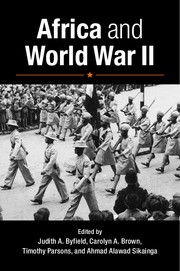Book contents
- Frontmatter
- Dedication
- Contents
- List of Contributors
- Acknowledgments
- Preface
- ONE INTRODUCTION
- TWO COLONIAL SUBJECTS AND IMPERIAL ARMIES
- 4 The Military, Race, and Resistance: The Conundrums of Recruiting Black South African Men during the Second World War
- 5 The Moroccan “Effort de Guerre” in World War II
- 6 Free to Coerce: Forced Labor during and after the Vichy Years in French West Africa
- 7 No Country Fit for Heroes: The Plight of Disabled Kenyan Veterans
- THREE MOBILIZING COMMUNITIES AND RESOURCES FOR THE WAR EFFORT
- FOUR RACE, GENDER, AND SOCIAL CHANGE IN A TIME OF WAR
- FIVE EXPERIENCING WAR IN AFRICA AND EUROPE
- SIX WORLD WAR II AND ANTICOLONIALISM
- SEVEN CONCLUSION
- Index
4 - The Military, Race, and Resistance: The Conundrums of Recruiting Black South African Men during the Second World War
from TWO - COLONIAL SUBJECTS AND IMPERIAL ARMIES
Published online by Cambridge University Press: 05 May 2015
- Frontmatter
- Dedication
- Contents
- List of Contributors
- Acknowledgments
- Preface
- ONE INTRODUCTION
- TWO COLONIAL SUBJECTS AND IMPERIAL ARMIES
- 4 The Military, Race, and Resistance: The Conundrums of Recruiting Black South African Men during the Second World War
- 5 The Moroccan “Effort de Guerre” in World War II
- 6 Free to Coerce: Forced Labor during and after the Vichy Years in French West Africa
- 7 No Country Fit for Heroes: The Plight of Disabled Kenyan Veterans
- THREE MOBILIZING COMMUNITIES AND RESOURCES FOR THE WAR EFFORT
- FOUR RACE, GENDER, AND SOCIAL CHANGE IN A TIME OF WAR
- FIVE EXPERIENCING WAR IN AFRICA AND EUROPE
- SIX WORLD WAR II AND ANTICOLONIALISM
- SEVEN CONCLUSION
- Index
Summary
Introduction
At the outbreak of the Second World War, South Africa joined the Allied forces; however, South Africa was ill-prepared for war. The Union Defence Force (UDF) had a small cohort of permanent staff of 260 officers and 4,600 men and was similarly ill-equipped with weapons. A drastic reorganization took place, with emphasis on recruitment. Race determined the focus of the initial recruitment drives: Recruitment of white male soldiers received immediate attention. White men who volunteered for service were deployed as frontline combatants serving in East Africa, North Africa, and eventually Italy. These men were involved in two important battles: The first was the defeat of the Allies at Tobruk, where a South African division had to surrender to the German Afrika Korps under General Erwin Rommel in June 1942, and at El Alamein, where the Afrika Korps was forced to retreat. As a result, the South African military command realized the urgency of expanding its forces, as had been the case in the First World War.
The expediencies of the war forced the government into mental gymnastics: it temporarily waived aspects of its racial policy of segregation, opening its recruitment drive to include black men, Indian men, and men of color. The Native Military Corps (NMC), under the control and command of the newly established Directorate of Non-European Army Services (DNEAS), was created under the command of Colonel Ernest Thomas Stubbs as a military unit specifically for black recruits. About 500 of the recruited black soldiers eventually served in North Africa.
The historiography on the participation of Africans in the Second World War has been quite extensive, with the latest book by David Killingray, Fighting for Britain: African Soldiers in the Second World War (2010), adding to the list. Academic works focusing specifically on recruitment of African soldiers during the Second World War are limited. The most important publications directly related to this chapter are those of Robert J. Gordon, Hamilton S. Simelane, and Ashley Jackson, all of them touching on aspects of recruitment.
- Type
- Chapter
- Information
- Africa and World War II , pp. 71 - 88Publisher: Cambridge University PressPrint publication year: 2015
- 1
- Cited by



